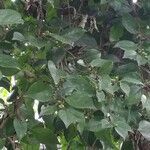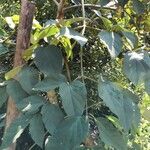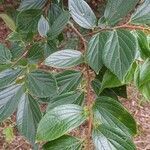Tree to 20 m high. Leaves ovate; lamina 4–10 cm long, glabrous, acuminate, entire in lower half, serrate in upper half; base rounded, oblique; venation 3-veined at base; lateral veins 6–8; petiole 0.5–1 cm long; stipules not seen. Inflorescence 1–few-flowered. Bisexual flowers usually 1–3 together; perianth lobes broadly ovate, c. 2 mm long; stamens slightly exceeding perianth; ovary cylindrical to ovoid, 1.5–3 mm long; stigmatic arms mostly divergent. Drupe globose, 7–9 mm long, orange to black; pedicel 0.4–1 cm long.
A large tree which loses its leaves. It grows 18 m tall. It forks fairly low and the crown is broad and irregular. The bark is smooth and grey. The leaves are dark glossy green above and olive green underneath. They are one sided at the base and they taper to a tip. There are teeth along the edge. The fruit are yellow and turn orange then black.
Deciduous tree, 10-30 m high, bark smooth to warty, pale grey, twigs puberulous, lenticels conspicuous. Leaves bright to dark green, glossy above, hairless or softly hairy on underside. Inflorescence yellowish, small, axillary; buds glabrous. Fruit ellipsoid, dark orange when mature on long stalk.




